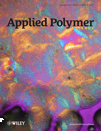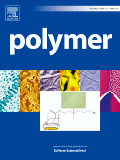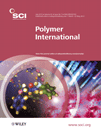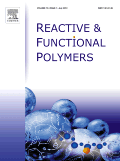
JOURNAL OF APPLIED POLYMER SCIENCE
Scope & Guideline
Pioneering Discoveries in Polymer Science
Introduction
Aims and Scopes
- Polymer Synthesis and Modification:
Research on new synthetic methods for polymers, including the development of novel monomers and the modification of existing polymers to enhance performance characteristics. - Nanocomposite Materials:
Exploration of the incorporation of nanoparticles into polymer matrices to improve mechanical, thermal, and electrical properties, as well as to develop multifunctional applications. - Biodegradable and Bio-based Polymers:
Investigation into sustainable polymers derived from natural resources, focusing on their degradation behavior and applications in environmentally friendly products. - Polymer Processing Technologies:
Studies on various processing techniques such as extrusion, injection molding, and 3D printing, exploring their effects on polymer properties and performance. - Polymer Characterization Techniques:
Utilization of advanced characterization methods to analyze the structure, morphology, and properties of polymers, aiding in the understanding of their behavior under different conditions. - Functional Polymers for Biomedical Applications:
Development of polymer systems aimed at medical applications, including drug delivery, tissue engineering, and wound healing. - Flame Retardancy and Safety of Polymers:
Research focused on enhancing the flame retardancy of polymers through innovative additives and formulations to improve safety standards in various applications. - Smart and Responsive Polymers:
Investigation into polymers that exhibit responsive behavior to external stimuli, such as temperature, pH, or light, leading to applications in sensors and actuators.
Trending and Emerging
- Sustainable Polymers and Recycling:
There is a growing emphasis on the development of sustainable, biodegradable polymers and the recycling of existing materials to reduce environmental impact. - Smart and Functional Materials:
Research into smart polymers that respond to environmental stimuli (e.g., temperature, pH) is on the rise, leading to innovative applications in sensors and actuators. - Nanostructured and Hybrid Materials:
The incorporation of nanomaterials into polymer matrices is trending, enhancing properties such as mechanical strength, thermal stability, and electrical conductivity. - 3D Printing and Additive Manufacturing:
There is an increasing focus on utilizing 3D printing technologies in the fabrication of complex polymer structures, with applications in biomedical devices and lightweight materials. - Polymer Composites for Energy Applications:
Research on polymer composites designed for energy storage and conversion technologies, such as batteries and supercapacitors, is gaining traction. - Bio-based Fillers and Additives:
The integration of bio-based fillers and additives into polymer formulations to enhance sustainability and performance is emerging as a significant area of interest. - Advanced Characterization Techniques:
The application of novel characterization techniques to study polymer behavior at the molecular level is trending, providing deeper insights into structure-property relationships. - Self-Healing and Reprocessable Polymers:
The development of self-healing and reprocessable polymers is a growing area, emphasizing sustainability and longevity in material performance.
Declining or Waning
- Conventional Polymer Blends:
Research focusing on simple blends of conventional polymers is becoming less prevalent as more complex, multifunctional materials and composites take priority. - Traditional Flame Retardants:
The use of traditional halogenated flame retardants is waning due to environmental concerns, leading to a decline in research focused solely on these materials. - Static Mechanical Testing:
There is a noticeable decrease in studies solely dedicated to static mechanical testing of polymers, as dynamic and real-world application simulations gain more interest. - Low-Performance Commodity Polymers:
Research on low-performance polymers without innovative modifications or enhancements is declining, as the focus shifts to high-performance and specialized materials.
Similar Journals

JOURNAL OF POLYMER SCIENCE
Elevating Polymer Science: Bridging Research and Real-World ApplicationsJOURNAL OF POLYMER SCIENCE, published by WILEY, is a premier, open-access journal dedicated to advancing the field of polymer science and its applications. With an ISSN of 2642-4150, it offers a platform for high-quality research and innovative ideas, contributing significantly to the understanding of polymaterials and their functionalities. The journal is recognized for its exceptional impact within various categories, consistently achieving Q1 rankings in Materials Chemistry, Physical and Theoretical Chemistry, and Polymers and Plastics, demonstrating its influential presence in the academic community. As of 2023, it holds a distinguished position in Scopus rankings, underscoring its relevance and rigorous peer-review process. By facilitating open access to vital research findings, the JOURNAL OF POLYMER SCIENCE plays a crucial role in fostering collaboration and knowledge transfer among researchers, professionals, and students, paving the way for innovative developments in polymer applications and materials science.

FIBERS AND POLYMERS
Transforming Ideas into Applications in Material ScienceFIBERS AND POLYMERS is a prestigious scholarly journal published by the Korean Fiber Society, specializing in the fields of Chemical Engineering, Chemistry, and Polymer Science. Since its inception in 2000, the journal has provided a dynamic platform for researchers and professionals to disseminate cutting-edge findings and innovative methodologies related to fibers, polymers, and their diverse applications. With its Q2 category ranking across multiple disciplines in 2023 and a commendable standing in Scopus rankings—ranking #183 in General Chemistry and #127 in General Chemical Engineering—it is well-regarded within the academic community. The journal’s commitment to quality research is further underscored by its comprehensive coverage of technological advancements and theoretical developments relevant to both industry and academia. Access to published articles may vary, and authors are encouraged to submit original research to contribute to this evolving field. Join the community shaping the future of materials science through FIBERS AND POLYMERS.

Polymer-Plastics Technology and Materials
Transforming Ideas into Material SolutionsPolymer-Plastics Technology and Materials is a premier academic journal published by Taylor & Francis Inc., dedicated to the dynamic fields of chemical engineering, materials chemistry, and polymers and plastics. With an impact factor that reinforces its reputation, this journal is strategically indexed in Scopus, ranked notably within its categories (Q2), showcasing its influence and relevance in the academic community. Since its inception in 2019, the journal has served as an essential platform for researchers, professionals, and students to disseminate innovative studies and advancements in polymer science and materials technology. As an Open Access publication, it ensures that cutting-edge research is accessible to a global audience, fostering collaboration and knowledge sharing in the material sciences. Located in the United Kingdom, Polymer-Plastics Technology and Materials continues to enhance the dialogue within the industry, addressing critical challenges and exploring emerging trends that shape the future of polymer and plastics technologies.

JOURNAL OF POLYMER RESEARCH
Advancing the Frontiers of Polymer ScienceJOURNAL OF POLYMER RESEARCH is a leading peer-reviewed journal published by SPRINGER, specializing in the dynamic fields of polymer science, materials chemistry, and organic chemistry. Operating since 1994, this esteemed journal has consistently delivered high-quality research articles that illuminate the latest advancements and innovations in polymer technology. With an increasing impact factor and placed in the Q2 category for both Materials Chemistry and Polymers and Plastics, it stands as a valuable resource for researchers, professionals, and students seeking cutting-edge knowledge in these areas. The journal is indexed in Scopus, highlighting its significance in the academic community, with notable rankings in Materials Science and Organic Chemistry. While it does not currently offer open access options, the meticulous selection of research and thorough peer-review process ensures each article's contribution to the field is both robust and impactful. Researchers aiming to expand their understanding and engage with pioneering studies will find JOURNAL OF POLYMER RESEARCH an indispensable platform.

POLYMER SCIENCE SERIES B
Fostering Excellence in Materials ResearchPOLYMER SCIENCE SERIES B is a distinguished journal published by MAIK NAUKA/INTERPERIODICA/SPRINGER, dedicated to advancing knowledge in the fields of ceramics and composites, materials chemistry, and polymers and plastics. The journal, identifiable by its ISSN 1560-0904 and E-ISSN 1555-6123, spans a significant timeline from 1996 to 2024, reflecting its commitment to preserving and disseminating cutting-edge research in polymer science. With its current ranking in the Q3 category across relevant fields, it supports scholars and professionals in enhancing their understanding and application of polymeric materials. While it operates on a non-open access basis, the journal is pivotal for researchers seeking in-depth analysis and peer-reviewed studies. Located in the heart of the United States at 233 Spring St, New York, NY 10013-1578, POLYMER SCIENCE SERIES B serves as an essential resource for committed researchers, professionals, and students aiming to push the boundaries of polymer science.

POLYMER
Driving Discoveries in the World of PolymersPOLYMER, an esteemed journal published by Elsevier Science Ltd, stands at the forefront of polymer science, presenting cutting-edge research that encompasses the realms of Materials Chemistry, Organic Chemistry, and Polymers and Plastics. With a remarkable impact factor reflecting its significance in the academic community, POLYMER has been a vital resource since its inception in 1960, contributing to a converged body of knowledge through to 2024. Rated Q1 in all relevant categories as of 2023, and boasting impressive Scopus rankings, this journal not only facilitates advanced discussions in polymer synthesis, characterization, and applications but also serves as a critical platform for collaborative research among scholars, professionals, and students. While it offers content primarily via subscription, POLYMER remains dedicated to fostering innovation and excellence in the field, making it an essential read for anyone passionate about polymer science.

INTERNATIONAL POLYMER PROCESSING
Unveiling the Future of Materials through Polymer ProcessingINTERNATIONAL POLYMER PROCESSING, published by WALTER DE GRUYTER GMBH, serves as a crucial platform for professionals and researchers in the fields of Chemical Engineering, Industrial and Manufacturing Engineering, and Materials Science, particularly focusing on polymers and plastics. With its ISSN 0930-777X and E-ISSN 2195-8602, this journal has been in circulation since 1988 and continues to expand its contributions to contemporary research trends through to 2024. Ranking in the third quartile across multiple categories, including Chemical Engineering (miscellaneous) and Materials Chemistry, it offers insightful and rigorous peer-reviewed articles that enhance the understanding of polymer processing technologies and innovations. This journal is vital for anyone engaged in polymer science and engineering, providing both theoretical and practical perspectives that advance the field. Although it does not provide open access, the journal's content is indispensable for academia and industry professionals looking to stay at the forefront of polymer research.

POLYMER INTERNATIONAL
Driving Excellence in Polymer ResearchPOLYMER INTERNATIONAL is a leading journal in the field of polymer science, published by Wiley, one of the most esteemed scholarly publishers. With an ISSN of 0959-8103 and an E-ISSN of 1097-0126, this journal has been a pivotal platform for researchers since its inception in 1991, now extending its coverage until 2024. The journal boasts a commendable standing in various scientific domains, achieving a Q2 quartile ranking in Materials Chemistry, Organic Chemistry, and Polymers and Plastics as of 2023. Additionally, it holds impressive Scopus ranks, including Rank #47 in Organic Chemistry and Rank #40 in Polymers and Plastics, placing it within the top percentiles of its categories. Researchers, professionals, and students alike can benefit from its rich array of articles that contribute to the understanding and advancement of polymer technology and materials science. Although not an open access journal, POLYMER INTERNATIONAL remains crucial for disseminating high-quality research that drives innovation and development within the field.

REACTIVE & FUNCTIONAL POLYMERS
Driving Innovation in Polymer Technologies and ApplicationsREACTIVE & FUNCTIONAL POLYMERS, published by Elsevier, is a leading journal in the field of polymer science, focusing on the innovative development and application of reactive and functional polymers. With an impressive impact demonstrated through its classification in various prestigious categories, including Q1 rankings in Chemical Engineering, Chemistry, and Materials Chemistry, this journal serves as an essential resource for researchers and professionals seeking to explore the latest advances in polymer research. With a broad scope that encompasses topics from biochemistry to environmental chemistry, and a convergence of significant findings from 1995 to 2024, REACTIVE & FUNCTIONAL POLYMERS fosters academic dialogue and collaboration among scientists. The journal also features Open Access options, ensuring that groundbreaking research is readily available to a global audience. By consistently publishing high-quality articles, it not only enriches the scientific community but also drives innovation across various industries reliant on polymer technologies.

Polymers
Advancing polymer science for a sustainable future.Polymers is a premier journal published by MDPI, dedicated to advancing the field of polymer science and technology. This open-access journal, established in 2009, has quickly gained prominence in the academic community, serving as a vital platform for disseminating high-quality research articles, reviews, and communications in the realms of chemistry, polymers, and plastics. Based in Switzerland, with an impressive ranking in the Q1 quartile for both Chemistry and Polymer studies, Polymers boasts a significant impact factor, reflecting its rigorous peer-review process and esteemed editorial board. Researchers, professionals, and students alike benefit from the broad accessibility of content, allowing for a more extensive reach and engagement within the scientific community. As a key resource for the latest advancements and innovations in polymer research, Polymers continues to lead discussions, inspire collaborations, and foster the development of novel materials that shape various industrial applications.